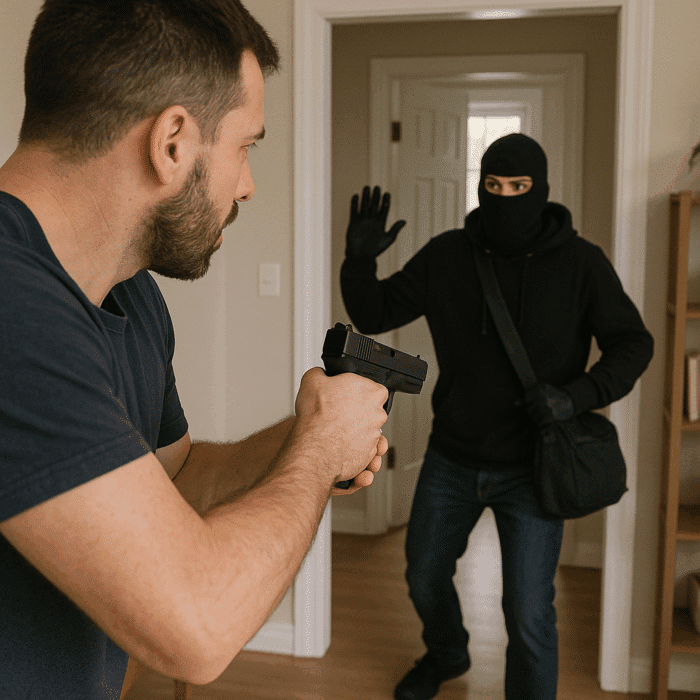Why Your Home is the Most Important Place to Carry Concealed
As a self-defense firearms instructor, I constantly remind students that carrying a concealed weapon isn’t just for when you’re out in public. Statistically, the one place you’re most likely to need your firearm isn’t at the grocery store, not at Starbucks, not walking through a parking garage — it’s at home.
The Surprising Truth: Where Defensive Gun Use Really Happens
According to a 2013 CDC study commissioned under President Obama, Americans use firearms for self-defense between 500,000 and 3 million times per year. Let that sink in. There are nearly as many defensive gun uses in the U.S. annually as there are home insurance claims for fire, lightning, or hail damage.
And this isn’t an isolated statistic. The 2021 National Firearms Survey estimated 1.67 million defensive gun uses each year. These are real incidents, with real lives saved — and the vast majority aren’t happening in dark alleys. They’re happening at home.
- 25% of all defensive gun uses occur inside the home.
- 53.4% happen on your property, such as in the driveway, garage, porch, or yard.
Put together, that means almost 80% of all defensive gun uses occur on your own property. Not while traveling. Not while shopping. Not in unfamiliar areas. At your own address.
Are You Carrying When It Matters Most?
Think honestly: do you carry when you’re mowing the lawn? Taking out the trash? Getting the mail?
The data says you should. The idea that home is always a safe place is a dangerous myth. A former FBI agent once noted that in all the home invasions he had investigated, he had never seen one occur in a house that had a dog. Why? Because criminals are cowards. They want easy targets, no resistance, and no surprises. A barking dog is one early-warning system. A responsibly armed homeowner is another.
When Seconds Count, Police Are Minutes Away
Another important factor is police response time. The national average is 10–15 minutes — but your life-threatening encounter will likely last just 3 seconds, involve 3 shots, and happen at a distance of 3 yards or less. That’s the “3-3-3 Rule” — and it’s terrifyingly common.
You won’t have time to call for help. You are the help.
And criminals know it: 57% of convicted felons say they fear armed citizens more than they fear police. That should tell you something about who really has the power to stop crime in the moment.
Most Defensive Gun Uses Don’t Involve Firing a Shot
Here’s another statistic that surprises many:
- 31% of attackers retreat the moment a homeowner informs them they are armed.
- 91.1% of defensive gun uses do not involve firing a shot.
That’s right — in over 9 out of 10 cases, simply displaying or verbally warning of a firearm ends the threat. No gunfire. No bloodshed. No tragedy.
And if you’re worried about misusing a firearm, consider this: for every gun used in a crime, guns are used in self-defense six times more often. That’s a 6:1 ratio in favor of saving lives, not taking them.
The Gender Factor: Compliance Isn’t Safer
For women especially, compliance with an attacker is not the safer option:
- Women who comply during an attack are 250% more likely to be injured than those who use a firearm in self-defense.
- Women who resist physically without a gun are 400% more likely to be injured.
Men aren’t exempt:
- Compliant men are 140% more likely to be hurt than those who defend with a firearm.
- Men who resist unarmed are 150% more likely to be injured.
This isn’t opinion — it comes straight from the Department of Justice’s National Crime Victimization Survey. The science is settled: responsible firearm ownership saves lives.
Final Thoughts: Are You Ready Where It Matters Most?
If you’re going to carry a concealed firearm, then carry where the data says it’s needed most — in and around your home. Defensive gun use happens on your property far more often than in public. But if you leave your firearm in the safe the moment you step inside, you’re playing the odds all wrong.
Every statistic in this discussion isn’t just a number — it represents a life. A mother who wasn’t assaulted. A father who protected his family. A woman who walked away instead of being hospitalized.
Get trained. Get educated. And carry responsibly — not just when you’re out, but especially when you’re home.
Your preparedness today may mean survival tomorrow. Be ready — not just out there, but right where you live.

